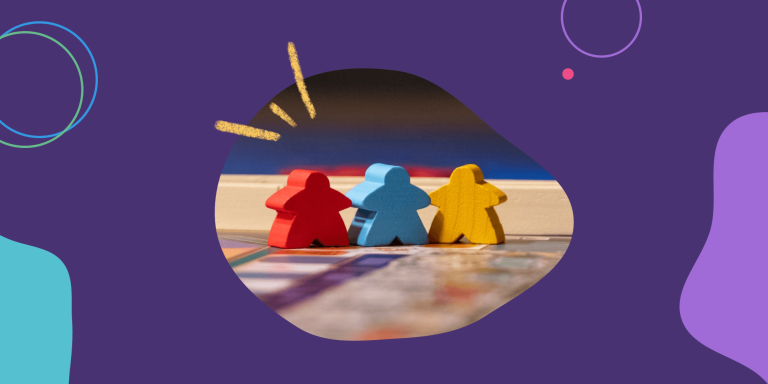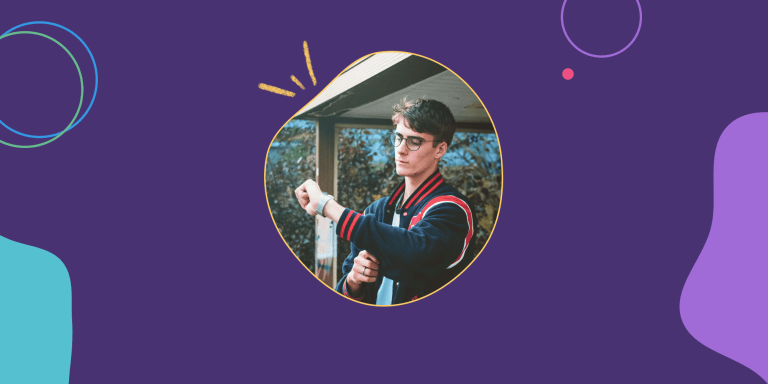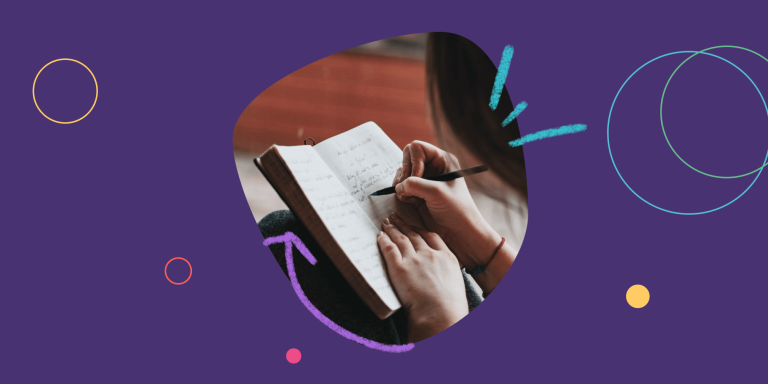7 Futurespective Ideas For Forward-Thinking Teams

Sprint retrospectives usually involve looking back over your last sprint. But futurespectives turn that process on its head.
Futurespectives are a bit like retrospectives except you look forward instead of backwards. The start of the year is the perfect time to look ahead with a futurespective and set some team goals for the year. But it’s not the only time to run a futurespective.
We’ve put together 7 futurespective, pre-mortem and retrospective ideas to help you reflect back and project forward in style:
Futurespective ideas:
What is a Futurespective?
Futurespectives are collaborative team meetings in which participants think ahead about potential challenges, goals, wishes, or anxieties they have or may run into. Futurespectives are a spin-off meeting type from retrospectives or lessons learned meetings, in which teams look back over their work to identify process improvements.
What are the benefits of Futurespectives?
Futurespectives are highly democratic meetings in which all team members come together to share their thoughts. Futurespectives can help teams:
- Pre-empt potential issues in upcoming projects. This gives teams an opportunity to pro-actively prevent or mitigate issues that may crop up.
- Share feelings openly with one another. Futurespectives encourage team members to share things they are anxious or excited about. By sharing hopes and fears, teams have a rare chance to align emotionally before a project begins.
- Plan ahead together. A Futurespective is a great way to get teams thinking about what they want to have achieved in a few months or even a year’s time.
- Debug working practices. Like a traditional retrospective, Futurespectives also help to reveal process improvements.
- Connect as a team. Futurespectives encourage your team to visualize how they will work together effectively. Having an open conversation about this early on can create stronger team bonds.
When to run a Futurespective
Try running a Futurespective anytime you need to look forward together as a team. For example:
- The start of the year: As a natural starting point and time for self-improvement planning, the start of the year is the perfect time for a futurespective. We recommend trying a Futurespective template that includes a retrospective and futurespective element, like the Hot Air Balloon futurespective. Alternatively, run a New Years Retrospective at the end of one year, and a Futurespective at the beginning of the next.
- According to planning cycles: When starting a planning cycle, you want to look ahead and debug potential problems, set a vision, and align on goals as a team. So try running a Futurespective to gather peoples’ hopes and fears, what they expect to learn from bets or experiments, or even how you will know if something was a success or not.
- Anytime as an individual practice: Futurespectives aren’t just for teams. You can use them as a personal planning practice. They work particularly well for people who want to visualise themselves at the end of the year and work backwards to figure out how to get there.
Futurespective templates and agenda ideas
We’ve put together 7 Futurespective templates you can try for your next meeting. All of these templates focus on a different aspect or theme. So there’s something here for everyone.
🎈 Hot Air Balloon Futurespective
Imagine your team are taking a picturesque trip on a hot air balloon. As you float along, you get to survey the rolling fields and hills from a great height.
But as you take in the sights, you also need to steer away from menacing storm clouds and towards clear skies – with additional fire and hot air to take you higher, or sandbags to come back down to earth.
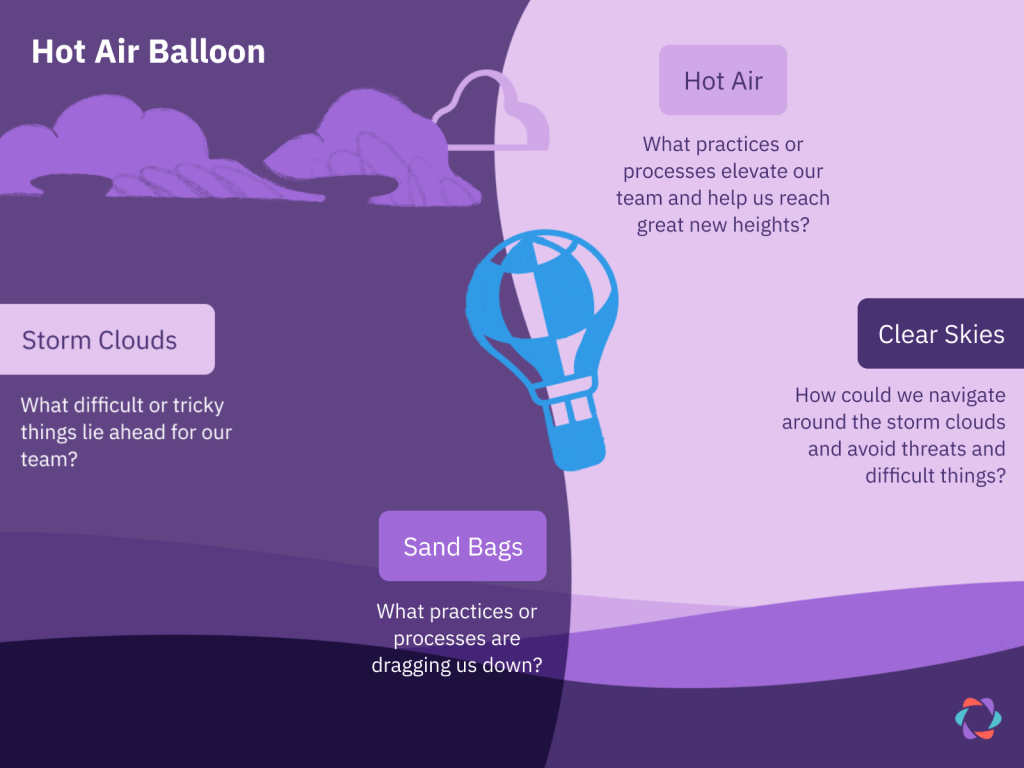
This futurespective idea offers teams a chance to think about their journey together and empowers them to take control of steering the ship away from hazards.
A creative and fun retro theme like this can help kickstart the year by bringing some energy to your team after the holidays. It’s a good choice for teams of visual learners who find it easier to think about their work with the aid of a metaphor.
Here’s how a hot air balloon futurespective works:
Looking Back (Hot Air & Sandbags)
The first step in this retrospective is to look back on the previous year or sprint. This part of the ascending and descending motion of a hot air balloon:
💨 Hot air
What practices or processes elevate our team and help us reach great new heights?
🪨 Sandbags
What practices or processes are dragging us down, making us slow, or demoralizing us?
Looking Ahead (Storm Clouds & Clear Skies)
The second set of prompts looks at the general weather the team could run into, so you can think about how to make sure your flight route is free of hazards.
🌩️ Storm clouds
What difficult or tricky things lie ahead for our team? What things could throw us off course or be dangerous?
☀️ Clear skies
How could we navigate around the storm clouds and avoid threats and difficult things? How could we push through storm clouds safely to reach clearer skies?
You can run this retrospective in an online retro tool with the category headings Hot Air, Sandbags, Storm Clouds, and Clear Skies.
🎖️ Pro-tip: Remember to explain to your team that the Hot Air and Sandbags are about looking back on previous experiences and the tools and actions that are under the team’s control. Storm Clouds and Clear Skies on the other hand are about looking ahead on your journey into the unknown.
Read more about the Hot Air Balloon Futurespective.
👑 Hero’s Journey Futurespective
This futurespective idea lets you imagine your team as an intrepid party of explorers on a quest to find a hidden treasure.
You’ve got all the skills you need on your self-managing team – a knight, a tactician, a summoner, a black magician, and even a white mage to heal your party along the way.
Now it’s time to sit down and think about what will make your quest for treasure a success and what hurdles could stand in your way for the year ahead.
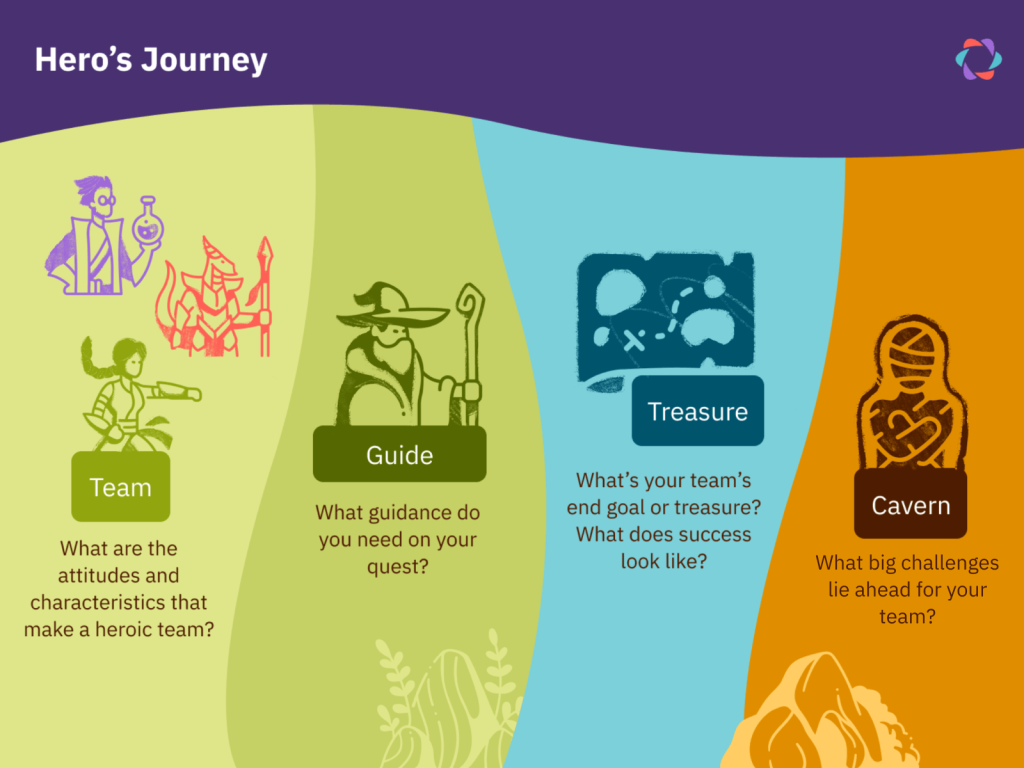
This futurespective idea gives teams an opportunity to focus in on the end goal of their work together and maintain a laser-focus on the results they want to achieve.
Here are the prompts to run a great Hero’s Journey futurespective with your team:
👥 Team
Think about your team and the skills and competences you have. Which ones are going to help you reach your goals. Think also about the attitudes and characteristics that make a heroic team.
🧙♂️ Guide
Your guide is the wise old wizard who gives your team timely (although cryptic) advice along the way. Think about who currently helps guide your team and what additional guidance your team might need on your quest.
🪙 Treasure
What’s your team’s end goal or treasure? What does success look like? What do you want to achieve in the year. I’m sure an ancient treasure chest with millions of twinkling gold coins would still be desirable, but it might not be realistic for your team.
🧟 Cavern
Every team faces adversity during their journey. Dragons, raiders, or just interfering stakeholders could be lurking around every corner. So think about the big challenges that lie ahead for your team.
👻 Psst, if you’re more into pirates, you can adapt this retrospective with the prompts Pirates, Map, Treasure, Cavern.
Read more about the Hero’s Journey Futurespective.
⚓ Hands on Deck Activity
The start of the year can be a good time to reflect on the different roles people play on your team. And also to make sure that every team member is starting the year off doing the work that suits their skills and desires best.
This futurespective gives teams an opportunity to think about their roles on the team with the help of a ship metaphor. On what specific areas are they leaders, active participants and helpers. And which specific parts of work would they rather not be doing.
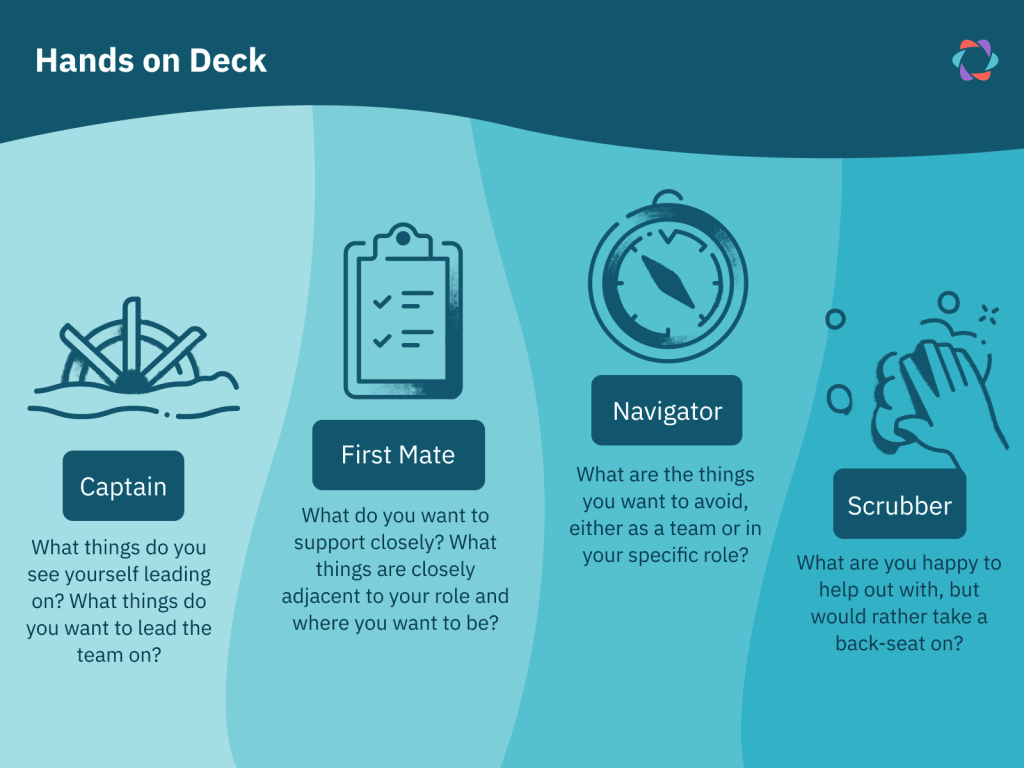
It also gives individual team-mates a chance to gain some perspective on their own roles, how they interact with others, and where they want to be more or less involved in specific parts of work.
Here are the prompts to help you run this Hands on Deck exercise:
🧑✈️ Captain
What things do you see yourself leading on? What things do you want to lead the team on? What do you want to take responsibility for?
✋ First Mate
What do you want to support closely? What things are closely adjacent to your role and where you want to be. You’re not a leader here, but you want to have a hand in what’s going on.
🧭 Navigator
What are the things you want to avoid, either as a team or in your specific role? Perhaps reviewing work looks like a big menacing iceberg to you. If so, note it down!
🧼 Deck-scrubber
What are you happy to help out with, but would rather take a back seat on? Perhaps reviewing work isn’t your favorite thing ever, but you’re happy to pitch in if someone needs a hand.
🙏 Hopes and Fears Futurespective
Teams might have a lot on their minds as the new year begins. This futurespective idea helps the whole team come together and have an open and wide-ranging discussion about their hopes and fears – what they’re looking forward to, and what they’re concerned about.
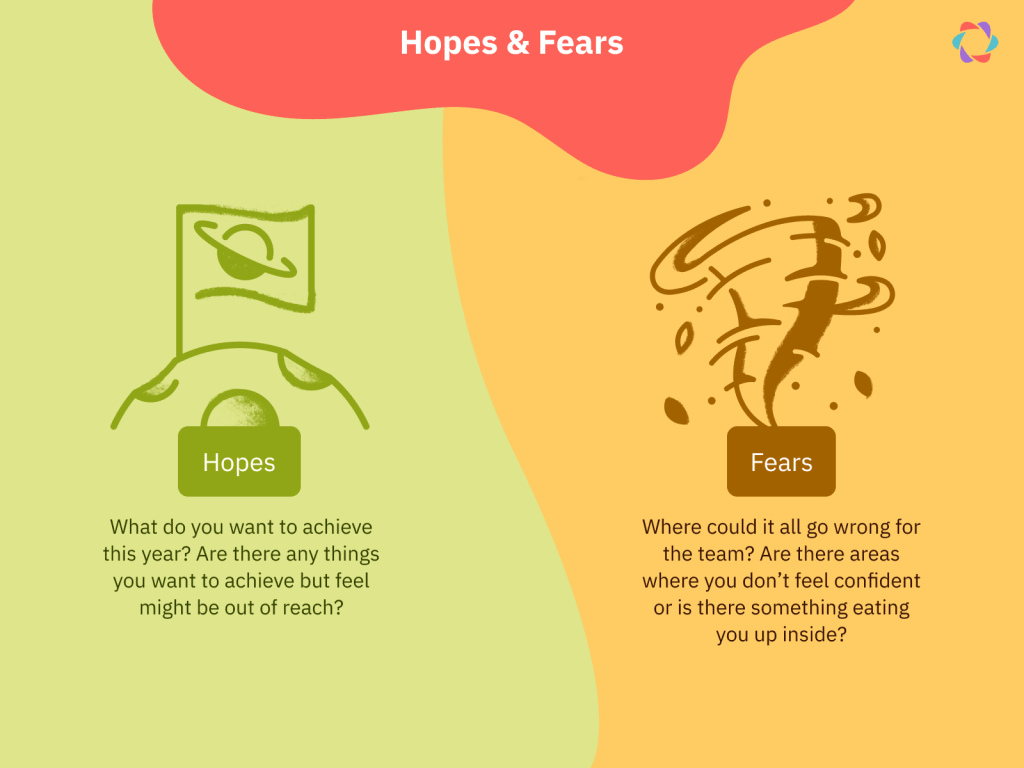
This futurespective is particularly helpful because it mixes personal, team-based, and product-based hopes and fears. That means you can have a deep and nuanced conversation to bond better as a team and understand how everyone feels.
Here are the prompts for a hopes and fears retrospective:
🙏 Hopes
What do you want to achieve this year? Is there a specific way you want work to feel or be achieved this year? Are there any things you want to achieve but feel might be out of reach? Jot them all down!
👻 Fears
Where could it all go wrong for the team? Are there areas where you don’t feel confident or is there something eating you up inside? What’s keeping you up at night?
🎖️ Pro-tip: For a more specific discussion, consider creating multiple hopes and fears prompts for the team to reflect on. For example:
- Product Progress – Hopes and Fears
- Personal Progress – Hopes and Fears
- Team Progress – Hopes and Fears
Read more about the Hopes and Fears Futurespective.
🎓 4Ls Pre-Mortem
You might already be familiar with the 4Ls retrospective: Liked, Learned, Lacked, Longed For. This retro idea also works very well as a pre-mortem or futurespective.
Confession: It’s become a company favourite here at Parabol for onboarding new collaborators and people at the final stage of our hiring process.
Running a pre-mortem at the start of the year involves projecting how you might feel at the end of the year. You can explain the process to your team by saying:
“Imagine we’ve worked the whole of the year together and it’s now December. Picture yourself in a years’ time reflecting on our work together: What are the things you could have liked, learned, lacked, or longed for?”
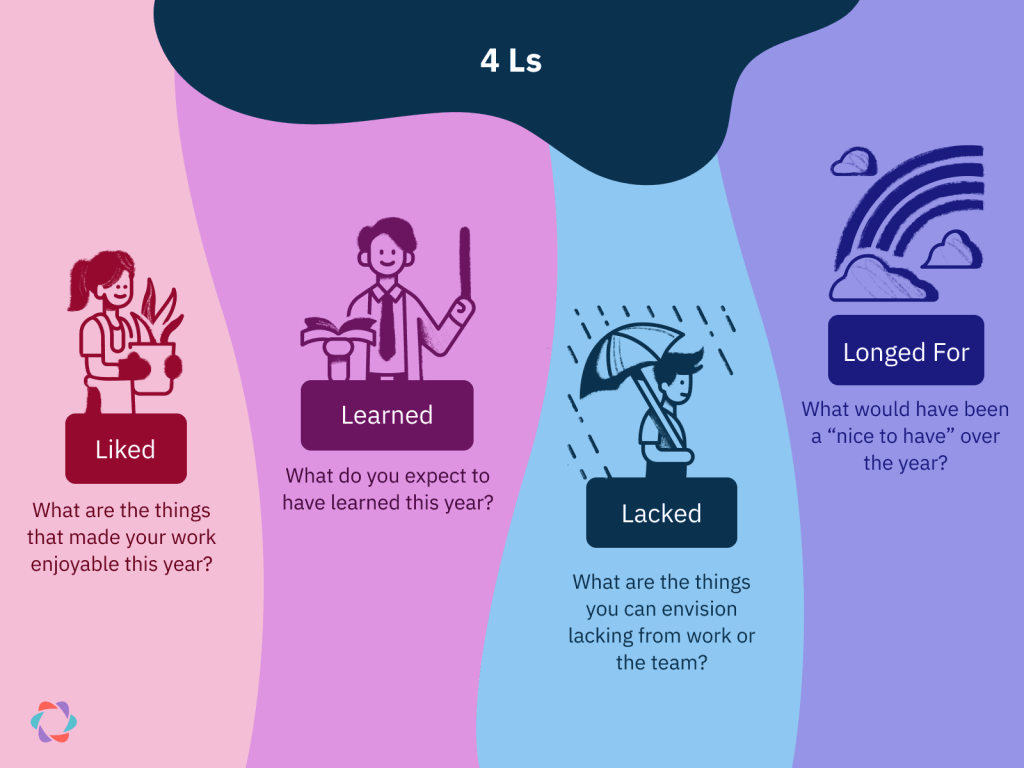
This process helps teams to think about what they want from their year of work (liked and longed for), what might be missing (lacked), and what they want to have discovered/how they want to have improved their craft (learned).
This helps your team manage their own expectations of their work and each other. It also gives an opportunity to make early changes and spot what could go wrong.
Here’s how the 4Ls pre-mortem works:
👍 Liked
Looking back from next December, what are the things that made your work enjoyable this year? What are the things you would have liked about how team-mates interact with you and each other? What good things would we have achieved by the end of the year?
🎓 Learned
What do you expect to have learned this year? This could cover customer/user needs, hard skills, career progression, or things you learned about working together.
😳 Lacked
What are the things you can envision lacking from work or the team? Perhaps it’s that you need a designer on the team, or perhaps it’s about receiving feedback, timely code-reviews, or something else entirely. These are the mission-critical things that may prevent you from doing your job effectively.
😩 Longed For
What would have been a “nice to have” over the year? These are things that wouldn’t significantly affect your ability to do your job effectively, but could have made it a bit easier or more pleasant.
🎖️ Pro-tip: As you reflect back from an imagined future, the year may have gone well, or it may have gone poorly. It’s helpful to imagine each future, one at a time, and write reflections from that perspective. You may find that some reflections are just mirrors of each other – in a good future, what you liked is the opposite of what you lack in a bad future – but some may be entirely different.
Read more about the 4Ls Futurespective.
💎 SWOT Retrospective
You may have thought that SWOT analyses are just for stuffy executives in consulting firms or MBA students, but they’re also a helpful activity for agile teams. A SWOT retrospective focuses on the team’s strengths, weaknesses, opportunities, and threats.
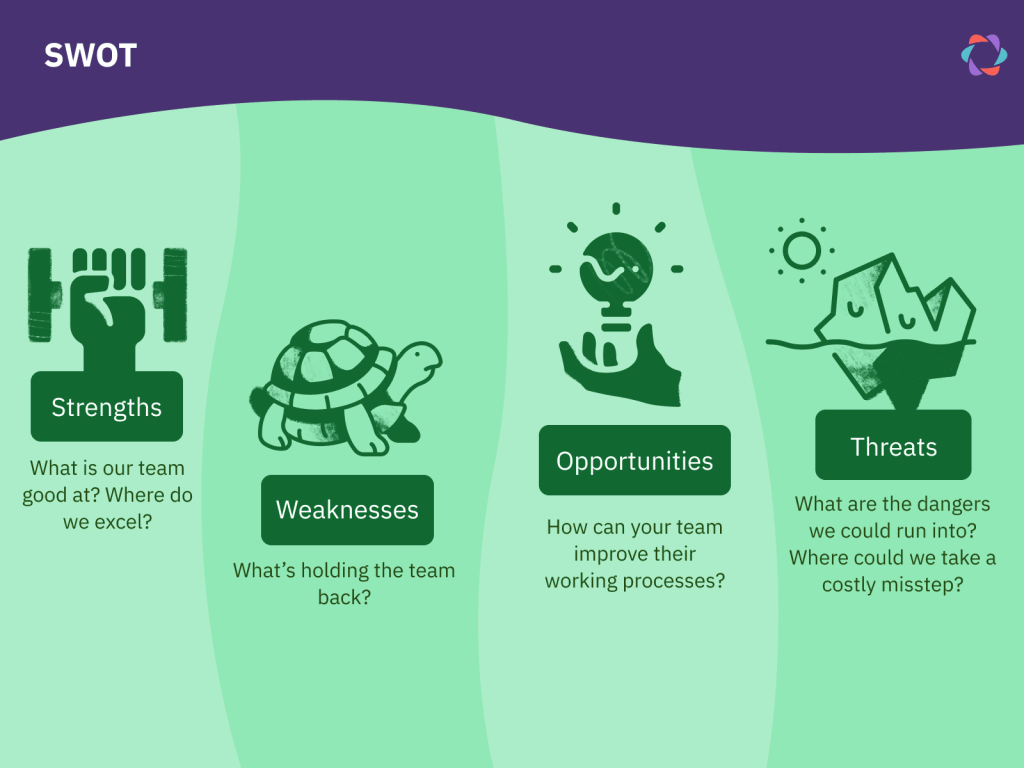
Starting the year with a SWOT analysis helps your team celebrate their strengths, identify weaknesses and threats that may stand in their way, and take advantage of opportunities for improvement in the new year.
You can set up a SWOT retrospective or SWOT analysis in your tool using the four headings of the model:
🏋️ Strengths
What is our team good at? Where do we excel? Are there areas where the team is competent and things run like clockwork? Consolidate your strengths and give a little kudos to each other!
😕 Weaknesses
What’s holding the team back? It could be technical skill on certain tasks, it could be staffing, it could be a process. Be honest about where the team has weaknesses so you can start the year building them into strengths.
⭐ Opportunities
How can your team improve their working processes? These are some easy wins or next steps that the team could choose to take advantage of. Note: Opportunities may include ways of resolving weaknesses.
⚠️ Threats
What are the dangers we could run into? Where could we take a costly misstep? Could any of our weaknesses be dangerous? If so, which?
The goal of a SWOT analysis is to transform your threats into opportunities and your weaknesses into strengths. So when it comes to planning action items ask your team the following questions:
- Are there any weaknesses we could turn into strengths?
- Are there any threats we could turn into opportunities?
Then, as always, make sure to document some action points and follow up in your next retro!
Read more about how to run a personal SWOT analysis and what questions to ask for better SWOT responses.
📅 Year in Review Retrospective
The end of one year and the beginning of another is a great time to zoom out and take stock of your team’s progress. A year in review retrospective can help teams visualize all they’ve achieved and get excited about what’s to come.
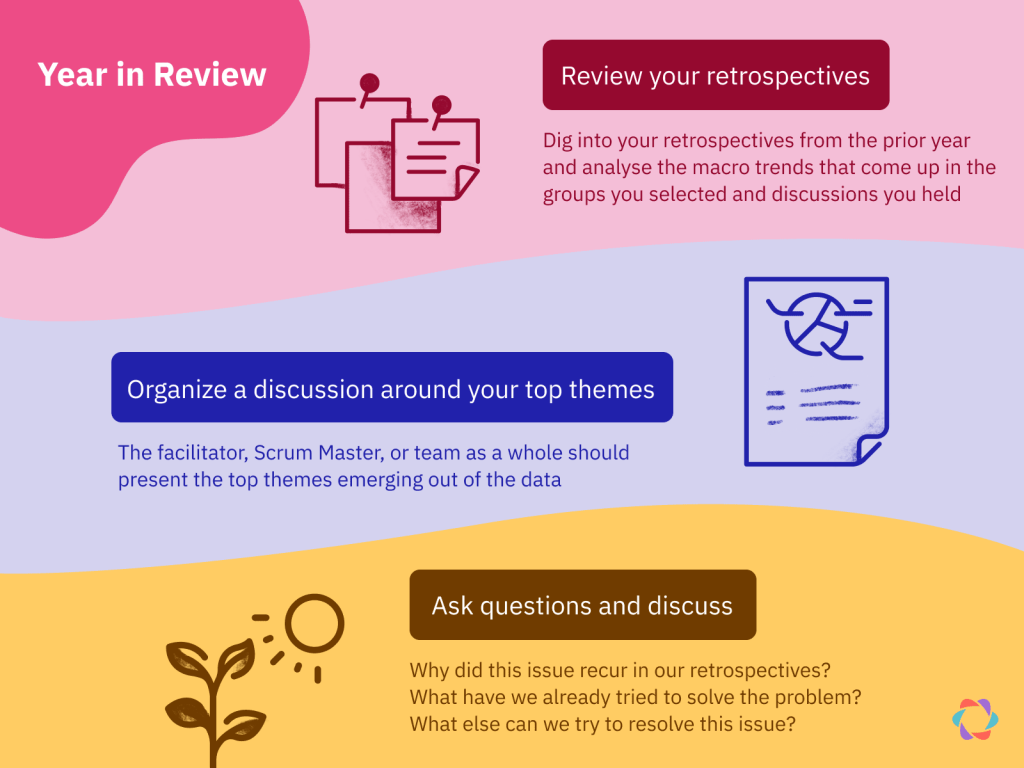
With a few months – or up to a whole year – of retrospective data under your belt, it helps you spot the thorny issues that keep coming up in retros.
Here’s how to facilitate a year in review retrospective.
1. Review your retrospectives
Dig into your retrospectives from the prior year and analyse the macro trends that come up in the groups you selected and discussions you held. If you use an online retrospective tool like Parabol, you can download all your retrospective data in CSV format. If you use an online whiteboard tool, you may have to do this manually. If you did all your retros on a physical whiteboard, we can’t help you – unless you want to do a bit of dumpster diving.
2. Organize a discussion around your top themes
Retrospectives usually involve team-mates coming up with reflections and co-creating a meeting agenda. In this retrospective, the facilitator, Scrum Master, or team as a whole should present the top themes emerging out of the data. You may want to present this data in advance, so team-mates have a little time to reflect deeply on the issues.
Pro tip: Make this even more interactive by treating your top issues from each retrospective as you would a regular reflection, then ask the team to group them into themes. This gives everyone the first-hand experience of seeing how often specific topics came up in the year.
3. Ask questions and discuss
Next, you’ll want to ask your team a few questions about the data. You can structure this discussion with a few fixed questions to interrogate your top themes:
- Why did this issue recur in our retrospectives?
- What have we already tried to solve the problem?
- What else can we try to resolve this issue?
Answering these questions should help the team find a meaningful route forward and take action.
You can also create a retro board with these three questions as headings, and ask the team to brainstorm their thoughts.
The benefit of a year in review retrospective is that it helps teams consolidate learnings from the prior year. But it also helps them get visibility over the macro trends in their work, which can get lost in the week-to-week rhythm of sprinting.
Start your year on the right track
Running a futurespective, retrospective, or pre-mortem is a great way to start your year off on the right track. It’s the one time of the year where it feels appropriate to zoom out and take in the bigger picture of your work together and consolidate last year’s learnings.
Aaron Dignan, author of Brave New Work, says:
“Continuous improvement is not magic; it is a discipline. It is a thing we do. And like all valuable things, it takes time. The average team doesn’t spend even thirty minutes a week reflecting on how they work together.”
If you can commit to running a start of year retrospective and follow through with the resulting action items, you’re already far ahead of most other teams.
If you’re struggling to run retros every two weeks, check out our advice on kick-starting a habit of regular retrospectives.
For more futurespective and retrospective ideas, check out some of our other blogs and resources:

